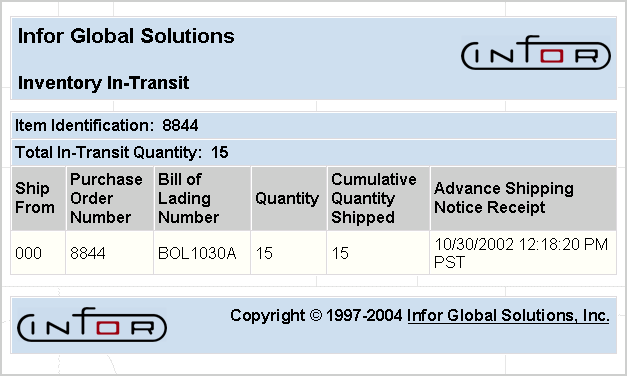Bookkeeping
Accounting for Goods in Transit Example

Have contingency plans in place for potential disruptions in the supply chain, such as alternative transportation routes or backup suppliers. Maintain optimal inventory levels by balancing the need to meet customer demand without overstocking, which ties up capital and resources. Well-trained staff can efficiently manage inventory, identify potential issues early, and contribute to the overall smooth operation of the supply chain.
Supply chain factors:
Merchandise Inventory increases (debit) and Accounts Payableincreases (credit) by the amount of the purchase, including allshipping, insurance, taxes, and fees [(40 × $60) + (40 × $5)]. Accounts Receivable (debit) and Sales (credit) increases for theamount of the sale (30 × $150). Cost of Goods Sold increases(debit) and Merchandise Inventory decreases (credit) for the costof sale (30 × $60). Delivery Expense increases (debit) and Cashdecreases (credit) for the delivery charge of $120. Led by Mohammad Ali (15+ years in inventory management software), the Cash Flow Inventory Content Team empowers SMBs with clear financial strategies. We translate complex financial concepts into clear, actionable strategies through a rigorous editorial process.
Strategies for Effective Transit Inventory Management:
Being prepared for disruptions ensures that the supply chain remains resilient and capable of adapting to unforeseen circumstances. Insurance coverage is often influenced by who owns the inventory at a given point in the transit process. Regular audits of your product portfolio will help you identify which items will need to be culled (or given a new transport method) so that your financials remain healthy. Unfortunately, this means that the terms and conditions of many shipping policies can be outdated and even lead to lawsuits if an especially discerning customer decides to nit-pick. Often when a business is starting out the owner will rush to quickly get all the right policies in place in time for the official launch.
- Inventory is a balance sheet asset account and cost of goods sold is an income statement account.
- Goods in transit are the products or materials which already leaves the seller’s warehouse but not yet received by the buyer.
- This method is particularly advantageous for sellers as it allows them to recognize revenue earlier.
- This may occur if the parent doesn’t record the sale of products however subsidiary records stock and accounts payable.
- In-Transit inventory allows for a continuous replenishment of stock, ensuring that stores can cater to the ever-changing demands of consumers.
Accounting for Goods in Transit: Key Practices and Considerations
The point of transfer is when the goods reach the buyer’s place of business. In the consolidated financial statement, we will combine the parent and subsidiary’s income statement and balance sheet. If there are the goods in transit during the reporting date, we must ensure that both party account correctly on those goods.
Understanding and Managing Asset Impairment in Financial Reporting

Short multiple-choice tests, you may evaluate your comprehension of Inventory Management. Many will also offer advice and recommendations for how you record and manage your accounts, as well as useful information about developing and sustaining your business. If you’re not confident with how you’re accounting for in-transit goods, you will likely benefit from speaking to a professional accountant or financial advisor. Follow Khatabook for the latest updates, news blogs, and articles related to micro, small and medium businesses (MSMEs), business tips, income tax, GST, salary, and accounting. Now that we know how to conduct the goods in transit entry for both parties in the case of FOB destination and FOB shipping point let’s learn about how to make a valuation of the goods in transit. In the case of FOB destination, Company B will make a sales entry for the date of August 1st, 2022, which differs from the sales entry made by Company S (i.e. June 22nd, 2022).
What is the approximate value of your cash savings and other investments?
As most of your purchases will probably fall under FOB shipping point, it’s a good idea to take a look at your small business’s insurance plan and consider adding transit coverage. This coverage should be included under inventory coverage and will protect you from lost or damaged inventory. Otherwise, there will be a mismatch between the asset and related liability. In order to record an account as “goods in transit, ” there must be evidence that the title has been transferred from the seller to the buyer. In this situation, goods in transit belong to the seller, and neither a sale nor a purchase is recorded until the goods reach the buyer.
In-transit inventory refers to items that have been shipped but have not yet arrived at the destination. The accounting for in-transit inventory depends to some extent on the shipment millions of americans might not get stimulus terms. If an item is shipped with the terms “FOB shipping point,” where FOB stands for “free on board,” the buyer pays the shipping fees and takes ownership at the seller’s warehouse.
The consignee, while not recording the goods as inventory, must ensure accurate tracking of sales and returns to provide reliable data to the consignor. Understanding the different types of goods in transit is essential for accurate accounting and financial reporting. These categories determine when ownership and risk transfer from the seller to the buyer, impacting how transactions are recorded.
If so, the dealer records a sale and a receivable or money and excludes the good in the ending stock. This may occur if the parent doesn’t record the sale of products however subsidiary records stock and accounts payable. In-Transit inventory acts as a crucial bridge in the supply chain, linking the production of goods with their eventual sale. It ensures a steady flow of products from manufacturers to retailers, enabling businesses to maintain consistent stock levels. This is calculated by multiplying the value of the inventory in transit by the carrying cost (the cost of storing the inventory while in transit) and dividing by 365. They describe stocks that have been paid for and shipped but have yet to reach their final destination.
For example, California Business Solutions (CBS) may purchase 30 computers from a manufacturer for $80 and part of the agreement is that CBS (the buyer) pays the shipping costs of $1,000. CBS would record the following entry to recognize the purchase of the goods and the freight-in. When managed and accounted for properly, in-transit inventory can be a great asset for small businesses.
If all your sales and inventory data is spread across multiple systems, you’re going to have a tough time building an accurate picture that encompasses everything. It’s essential to have a proper contingency plan in place in case something happens to your in-transit inventory. If the inventory you’ve purchased is classified as an FOB shipping point, you can list it as new inventory in your system as soon as it ships. For example, a used car dealership might list a preowned vehicle on its website as available for purchase even if it’s not physically on the lot yet.
